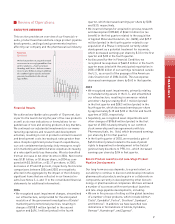Eli Lilly 2004 Annual Report Download - page 20
Download and view the complete annual report
Please find page 20 of the 2004 Eli Lilly annual report below. You can navigate through the pages in the report by either clicking on the pages listed below, or by using the keyword search tool below to find specific information within the annual report.
FINANCIALS
18
tions. Although the deduction is subject to a number
of limitations and uncertainty remains as to how to
interpret certain provisions of the AJCA, we believe we
have the information necessary to make an informed
decision on the impact of the AJCA on our repatriation
plans. Based on that decision, we plan to repatriate
$8.00 billion in incentive dividends, as defi ned in the
AJCA, during 2005 and accordingly have recorded a
related tax liability of $465.0 million as of December
31, 2004. Potential uses of proceeds from the incentive
dividends include research and development activities,
capital asset expenditures, and other permitted activi-
ties. As noted above, in anticipation of the repatriation
of overseas earnings into the U.S. in 2005, we began to
liquidate our long-term investments held international-
ly during the latter part of 2004 into cash, cash equiva-
lents and short-term investments.
We believe that cash generated from operations,
along with available cash and cash equivalents, will be
suffi cient to fund our operating needs, including debt
service, capital expenditures, dividends, and taxes in
2005. We believe that amounts available through our
existing commercial paper program should be adequate
to fund maturities of short-term borrowings, if neces-
sary. Our commercial paper program is also currently
Return on Shareholders’ Equity
(based on income from continuing operations
divided by average shareholders’ equity)
Return on shareholders’ equity declined
in 2004, to 17.5 percent. This decline is
primarily attributable to additional tax
expense associated with the anticipated
repatriation of earnings as the result
of the American Jobs Creation Act and
charges related to both acquired in-
process research and development and
restructuring activities. In addition, we
made substantial investments in our
manufacturing operations and research
and development activities.
95 96 97 98 99 00 01 02 03 04
55.3%
53.9%
46.0%
37.5%
28.2%
26.1%
42.3%
35.2%
28.4%
17.5%
backed by $1.25 billion of unused committed bank credit
facilities. We will likely repay our outstanding commer-
cial paper and a portion of our other debt during 2005
using available cash. Various risks and uncertainties,
including those discussed in the Financial Expectations
for 2005 section, may affect our operating results and
cash generated from operations.
In the normal course of business, our operations
are exposed to fl uctuations in interest rates and cur-
rency values. These fl uctuations can vary the costs
of fi nancing, investing, and operating. We address a
portion of these risks through a controlled program of
risk management that includes the use of derivative
fi nancial instruments. The objective of controlling these
risks is to limit the impact on earnings of fl uctuations
in interest and currency exchange rates. All derivative
activities are for purposes other than trading.
Our primary interest rate risk exposure results
from changes in short-term U.S. dollar interest rates.
In an effort to manage interest rate exposures, we
strive to achieve an acceptable balance between fi xed
and fl oating rate debt positions and may enter into
interest rate derivatives to help maintain that balance.
Based on our overall interest rate exposure at Decem-
ber 31, 2004 and 2003, including derivatives and other
interest rate risk-sensitive instruments, a hypothetical
10 percent change in interest rates applied to the fair
value of the instruments as of December 31, 2004 and
2003, respectively, would have no material impact on
earnings, cash fl ows, or fair values of interest rate risk-
sensitive instruments over a one-year period.
Our foreign currency risk exposure results from
fl uctuating currency exchange rates, primarily the U.S.
dollar against the euro and the Japanese yen. We face
transactional currency exposures that arise when we
enter into transactions, generally on an intercompany
basis, denominated in currencies other than the local
currency. We also face currency exposure that arises
from translating the results of our global operations to
the U.S. dollar at exchange rates that have fl uctuated
from the beginning of the period. We use forward con-
tracts and purchased options to manage our foreign cur-
rency exposures. Our policy outlines the minimum and
maximum hedge coverage of such exposures. Gains and
losses on these derivative positions offset, in part, the
impact of currency fl uctuations on the existing assets,
liabilities, commitments, and anticipated revenues. Con-
sidering our derivative fi nancial instruments outstanding
at December 31, 2004 and 2003, a hypothetical 10 per-
cent change in exchange rates (primarily against the U.S.
dollar) as of December 31, 2004 and 2003, respectively,
would have no material impact on earnings, cash fl ows,
or fair values of foreign currency rate risk-sensitive
instruments over a one-year period. These calculations
do not refl ect the impact of the exchange gains or losses
on the underlying positions that would be offset, in part,
Dividends Paid Per Share
(dollars)
Dividends paid during 2004 increased to $1.42 per
share. This constitutes the 37th consecutive increase
in annual dividends. The company also continues this
tradition into 2005 by declaring a first-quarter 2005
dividend of $.38 per share, a 7 percent increase over
first-quarter 2004. This record clearly reflects our
continued commitment to delivering outstanding
shareholder value.
$1.04
$1.12
$1.24
$1.34
$1.42
00 01 02 03 04
























